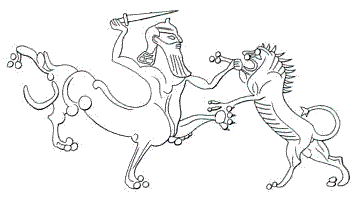I've had some success pinning down the ancient mythological antecedents for wemics in a couple earlier screeds here and here ... but I've found a few more tidbits to share.
The folks at Google, bless their busy brains, have been putting the content of entire books online in searchable form. Google Print is an experimental service (still in beta), but it served up two nifty hits when I went a-searching for "lion centaurs."
The first is the book, "Gods, Demons and Symbols of Ancient Mesopotamia," by Jeremy Black and Anthony Green, that was recommended to me by Prof. Zainab Bahrani. Google was kind enough to show me the page I needed, on which I found this:
lion-centaur
The so-called lion-centaur of Middle Assyrian and Neo-Assyrian art is a hybrid creature with a lion's lower body (including all four legs) and the head, upper body and arms and hands of a man. He often wears the horned cap of divinity. The creature's name was urmahlullu, "lion-man."
Representations of him were placed outside ablutions rooms, where he fended off the attacks of the leonine demon Mukil-res-lemutti, "evil-attendant."
That quote also came with this illustration, drawn from a cylinder seal of which I have a photo, of a lion-centaur:

The book also includes a page with a photo of a bas-relief of a lion-centaur. Prof. John M. Russell sent me a different photo of the same work of art. Here's the photo from Black and Green:

The second hit I got from Google Print had no art, but it was a source of which I had never heard. The book has this odd name: "Magickal Mystical Creatures: Invite Their Powers Into Your Life." Written by D. J. Conway, who Amazon tells me is also the author of "A Little Book of Pendulum Magic" and "Shapeshifter Tarot," the book seems to be a fairly wide-ranging beastiary of fantastic creatures. Regarding lion-centaurs, Google Print offered me the following from this page of Conway's book:
A type of lion-centaur also appears in Assyrian art. This creature had a lion's body with four legs, and the upper body, head, and arms of a human male. He was called urmahlullu (lion-man). His form was placed outside ablution rooms so he could protect against the Lion-Demon Mikil-res-lemutti (evil attendant). One can only speculate as to what this "evil attendant" did; perhaps he represented tainted water or thieves who attacked the bathers.
My guess, from the mention of "Mikil-res-lemutti," "evil attendent," and "ablution room," is that Conway is using Black and Green as a primary reference, or that they are all using the same source. Note that in his book, F. A. M. Wiggermann refers to the evil demon as "Sulak," and the "ablution rooms" as "lavatories."
But Conway also turned up a new (to me) reference to wemics in the Middle Ages! On this page, Conway has this remarkable thing to say:
The most famous coat of arms bearing a Centaur belonged to King Stephen, who invaded England in 1135. However, Stephen's Centaurs are sometimes shown with the body of a lion instead of a horse.
Huh! Wemics in English heraldry -- that's news to me! So I did some more Google sleuthing, and came up with a little more.
King Stephen was the last Norman king of England, a grandson of William the Conqueror. From this essay on medieval centaurs, I found this:
The "English" king Stephen of the short-lived dynasty of Blois was said to have the arms: Gules, three sagittary or. (The sagittaries are depicted with a leonine appearance.)
It turns out that a "sagittary" is a centaur archer, or a wemic archer, or a beastly archer, usually in heraldry, but used elsewhere too. From Shakespeare's Troilus and Cressida, we find in Agamemnon's recitation of battle losses (in the Trojan War), this: "the dreadful Sagittary / Appals our numbers." Whether Shakespeare meant human archers, or centaur archers, or even wemic archers, I'll leave to another screed.
Anyway, King Stephen's sagittaries evidently were wemic-like. Here's another quote, from a SCA-oriented Web page on heraldry:
A sagittary is a centaur drawing a bow and arrow. A leonine-centaur has the body of a lion, instead of a horse; it is found in the attributed arms of King Stephen of England, c.1097.
For a future screed: finding a picture of King Stephen's coat of arms.